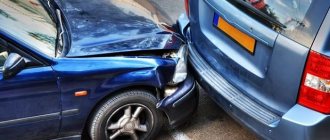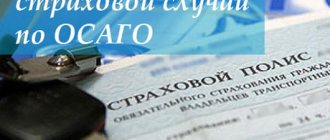Publication date: 03/04/2019 Number of views: 5857
Author: Ermakov Andrey Valerievich Lawyer, partner of the Legal Agency of St. Petersburg Articles written: 20
The situation when an insurance company files a lawsuit against the culprit of an accident in order to recover material damage based on the compensation paid to the injured party is becoming more and more common every year. If previously relatively little-known organizations that had close ties with collection agencies committed similar sins, today you can get a claim for subrogation or recourse from almost any insurance company. Recently, there has been increased activity on the part of the insurance company, which is trying to compensate for its losses under CASCO or OSAGO contracts by filing lawsuits against those responsible for the accident. There is a trend: if the accident occurred in 2015 or 2021 (the statute of limitations is about to expire), and the amount of paid material damage exceeds 100-120 thousand rubles, you can expect a quick summons from the court. There are many explanations for this: the unstable economic situation in the country, a sharply increased number of vehicles, competition in the market, tightening legislation in the field of insurance companies. In order to somehow preserve their assets and not become bankrupt, they are forced to resort to subrogation and recourse claims. What to do if the insurance company sues the person responsible for the accident, what is the difference between recourse and subrogation, is it possible to reduce the amount of payments for a lawsuit and how to protect your property rights? Answers to these and related questions are provided by professional lawyers in the field of insurance law and civil law.
Is a partial refund possible?
The insurer pays damages according to the amount determined by the vehicle assessment expert.
The most common situations occur when an expert establishes a certain amount of damage, after which the victim declares that the damage caused is more than established. In these cases, the victim turns to the culprit of the incident with a demand to pay the resulting difference. The appeal occurs to the culprit, and not to the insurance company, precisely because it will be much easier to receive payment directly from a specific person than from the insurance company.
In what cases is compensation required?
Insurance claim: rules for filing
Insurance Fraud
Pre-trial settlement of insurance disputes
There are several cases in which insurance companies require the culprit to pay for damages from an accident:
- By way of subrogation (Article 965 of the Civil Code of the Russian Federation), the insurance company demands that the culprit reimburse the funds that it paid to its client under CASCO. Thus, initially the insurance company pays money to its client, after which it recovers the same amount from the culprit of the accident;
- By way of recourse (Article 1081 of the Civil Code of the Russian Federation) under compulsory motor liability insurance, in accordance with Federal Law No. 223, Article 14 . In other words, the insurer demands compensation for the damage that was paid to the victim under the compulsory insurance policy.
The reasons for applying recourse are special illegal actions of the perpetrator of the incident, which are discussed in detail in Article 14 of the Federal Law.
Namely:
- The culprit of the accident specifically caused harm to the life or health of the victim;
- The culprit caused harm while driving in a state of alcohol (or other) intoxication;
- The culprit did not have the right to use the car (for example, there was no license);
- The culprit fled the scene of the accident.
When is compensation required?
The Federal Law “On Compulsory Motor Liability Insurance” No. 40-FZ actually gives the insurance company the right to put forward recourse claims in order to recover from the culprit of the accident the losses that it incurred in the process of compensating the damage to the party injured in the accident. However, the provisions of Article 14 of this law establish a clear list of cases when such a requirement can be raised. The basis for recourse under compulsory motor liability insurance may be the proven fact that the culprit of the traffic accident:
- intentionally caused a collision with a pedestrian or damage to the property of another traffic participant;
- the driver was under the influence of alcohol, narcotic or psychotropic drugs;
- fled the scene of a traffic accident;
- did not have the right to drive a car because he does not have a compulsory motor liability insurance policy, does not have a driver’s license or is not included in the list of drivers of this vehicle;
- transported passengers as a taxi without having a valid maintenance ticket.
It turns out that in case of recourse, the insurance company recovers losses from its own client, who, as a result of his violation of the requirements of traffic rules and the Code of Administrative Offenses, allowed an emergency to occur, which resulted in insurance payments in favor of the injured party.
In addition, the insurance company has the right to demand compensation for losses from the person responsible for the accident, exercising its right to subrogation after paying the damage to the CASCO policy holder. If, as a result of the accident, the insurer compensated under the CASCO program for the cost of repairing both damaged cars, it gets the opportunity to recover its losses from the person responsible for the accident.
If there is no third party in the incident, and the CASCO policy holder himself drove into a curb in the yard, scratching his own car, the insurer, after making the payment, does not have the right to demand compensation from him for expenses.
Pre-trial practice
Pre-trial proceedings are carried out, as a rule, with subrogation under CASCO. Initially, the insurance company does not sue the culprit, but sends him a claim, urging him to compensate for the damage of his own free will. It is worth noting that the culprit may receive a letter of claim 2 – 2.5 years after the traffic accident. However, here it is important to understand how justified the requested amount is and whether you need to defend your rights or is it better to agree on an installment plan. As a rule, insurance companies are cooperative when it comes to installment plans.
Procedure for filing a claim
It often happens that the insurance claim is a paper stating the fact of the accident, listing the articles of the law and issuing an invoice. This requirement is unfounded, since a number of documents must be attached to it, namely :
- Official papers confirming the amount of damage caused: a report on the inspection of the vehicle by experts with a detailed description of the damage. Original photographs and an estimate of the amount of repairs, or a receipt for payment must also be attached;
- Papers that confirm guilt: a certificate of a traffic accident, a conclusion on an administrative violation or a court conclusion;
- Papers that confirm the right to subrogation: a copy of the vehicle’s passport, a photocopy of the policy and payment receipt, a copy of the insured person’s statement that an insured event has occurred.
Additional documents:
- Only after the insurance company pays compensation to the victim does it have the right to recover funds from the culprit;
- Therefore, the amount of the monetary claim against the perpetrator must be within the amount paid to the victim.
Note: the employer must pay for the culprit of a traffic accident who became such while fulfilling his official obligations.
Step-by-step instructions for compensation for damage from the culprit of an accident through the court in 2021
IMPORTANT
Collection of funds from the culprit of the accident can only be carried out after he has been identified. The protocol records only the fact of violation. Guilt is determined in court.
To initiate proceedings, a citizen must go to court. You should not delay in collecting damages from the culprit of the accident through the court. The limitation period is 3 years. The rule is enshrined in Article 196 of the Civil Code of the Russian Federation. If the amount of damage does not exceed 50,000 rubles, an application must be submitted to a magistrate. If you request larger compensation, you must contact the district court. When filing a claim, you will have to pay a state fee. Its size depends on the amount collected. When going to court, you need to proceed according to the following scheme:
- Make a pre-trial claim. If there is no response, or the citizen refuses to compensate for the damage caused, you need to prepare a package of documents.
- Draw up a statement of claim and submit it to the court office. The document must be drawn up correctly. Errors will be grounds for denial of further proceedings.
- Receive a subpoena and appear at the hearing.
- Take part in the meeting.
- Wait for the decision to be made. If the verdict is positive, the citizen will be able to recover the funds.
for compensation for damages from the culprit of the accident in WORD format.
If the defendant is in no hurry to make a payment, enforcement proceedings can be initiated. The bailiff will give the citizen 10 days to voluntarily repay the debt. If the action is not carried out, it is permissible to confiscate part of the personal property to cover the obligations. Additionally, it is possible to force a portion of funds to be written off from all types of earnings. The money is transferred to the victim’s bank account. Details are indicated in the application to initiate enforcement proceedings. When payment is granted, the case is closed.
Legal assistance
If after an accident the insurance company demands compensation for damages, you should contact an experienced lawyer. He can use several protection methods:
- Reduce the amount of damage caused in an accident . If the insurance company reimburses the victim or its client, the at-fault party has the right to dispute the amount of the payment. The insurance company has the right to request compensation for damage only if it was correctly calculated;
- Appeal the legality of the payment . In this situation, a general legal examination of the official papers is carried out, which became the basis for the insurance company to pay its client. If it is discovered that there are errors in the documents, or if it is determined that there are not enough documents, the payment is considered illegal. Thus, the insurance company is deprived of the right to demand compensation for damage from the culprit of the road accident;
- Appeal the fault of the person responsible for the accident . In some cases, during an examination, lawyers reveal that the person at fault in the traffic accident is not guilty, or is partially guilty. And here, even when a claim has been received from the insurance company stating that you are the culprit of the road accident, you have the right to try to prove your innocence in court.
Step-by-step instructions for compensation for damage from the culprit of an accident under compulsory motor liability insurance
The process of compensation for damage under compulsory motor liability insurance is regulated by Federal Law No. 40 of April 25, 2002. The procedure is as follows:
- The accident is documented. A traffic police officer takes part in the process. If conditions are present, the use of the Euro protocol is acceptable.
- The citizen notifies his insurance company about the incident. All further actions are carried out on behalf of the representative of the organization.
- The person prepares the necessary documents. The list of securities is reflected in clause 3.10 of the rules for OSAGO P-431. Additionally, an examination of the vehicle is carried out to determine the amount of damage caused to the vehicle.
- Based on the results of the procedures performed, a decision is made to provide compensation or refuse payment. If the decision is positive, payment is made to the insurer's account. The registration procedure is carried out at the organization’s office.
- Directions for repair work or payment of funds are provided.
Compensation for damage from the culprit of an accident under compulsory motor liability insurance is carried out only if the culprit of the accident has a valid contract on compulsory motor insurance. The payout limit is limited. In 2021, the insurance company can allocate up to 500,000 rubles for events related to health restoration. If we are talking about compensation for loss of property, the amount is limited to a limit of 400,000 rubles.
The main document required to receive payment is an application. It is submitted to the insurance company. The document must be completed correctly. Additionally, the following documents will be required:
- notification of an accident;
- completed protocol and resolution (if drawn up);
- a copy of the applicant's passport;
- PTS and STS;
- documented account number to which funds will be transferred;
- a copy of the refusal to initiate an administrative case, if the document has been completed.
to receive payment under compulsory motor liability insurance in WORD format.
Can insurers cheat?
There are frequent cases when, during subrogation, the insurance company demands compensation for damage in an amount greater than that which was reimbursed to the client . For these purposes, they provide dubious calculations that can be easily challenged by a professional either before the trial or in court itself. This means that you should not immediately pay the invoice issued to you in your claim. When there is doubt about whether the repair amount is real, it is recommended to understand all the documents that contain information about the damage assessment, and also check the accuracy of all calculations. You can check your calculations by answering the questions below:
- To what extent do car repair work correspond to the damage indicated in the traffic accident certificate? Perhaps you will find damage that is not justified?
- Perhaps there are unnecessary parts on the list of parts to be replaced?
- Perhaps the same spare parts were counted several times?
- How realistic are the cost of parts and standard hours?
It happens when insurers falsify documents in the hope that the person responsible for the accident is incompetent. For example, the injured driver estimated the cost of repairing his car at a much higher amount than the insurance company paid him. And insurers, demanding compensation for losses, present the documents submitted by the victims to the culprit of the accident.
Tags:










